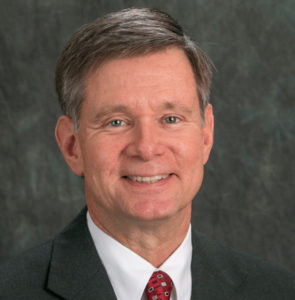What Does Age Have to Do With It?

The Rev. Kenneth V. Daniel
By the Rev. Kenneth V. Daniel, president and CEO, United Church Homes
The Impact of Clergy Age on Churches
When I was ordained back in 1981, I accepted the call to serve St. Andrew’s UCC, a small congregation in the old industrial city of Reading, Pennsylvania. I was following a beloved, long-tenured pastor who had served for 27 years there. I was 26 years old at that time. When the local newspaper published the announcement of my election, accompanied by a photo, one of the parishioners commented that I looked like a kid in high school. And I probably did!
I recently read a report from the UCC’s Center for Analytics, Research and Data called How Does Clergy Age Impact Churches? The author cites a number of studies, not only from the denomination but also from outside sources. While it is true that the average age of clergy in the UCC has risen from 44 in 1992 to 54 in 2017, it is also true that the percentage of church leaders 65 and older has nearly tripled since 1992.
The report cites another study Congregations and Change: Findings from the FACT 2015 Survey by the Rev. Kristina Lizardy-Hajbi, PhD. Focusing on elements making for “high-change” vs. “no/slow-change” congregations, the study concluded that high-change churches correlate to younger clergy.
But Does Age Correlate to Church Vitality?
As a professional working in the senior living industry, I paused when first reading this report. I don’t want to believe that the age of a pastor correlates to the health or growth rate of a congregation. How can that be the only key variable that determines whether a church demonstrates vitality? There must be several significant other variables that correlate to church vitality.
The socio-economic changes of recent years have taken their toll on churches in the UCC. As is true in Reading, Pa., younger people have moved out of communities hard hit by recession and job loss, further increasing the average age of many churches. Millennials are attracted to careers with a purpose of helping others. However, they also tend to disregard the church as a viable career path, due to the declining reputation and marginalization of organized religion in our society. Many congregations today can no longer afford to offer competitive salary and benefits, or even full-time employment to their pastors. This also skews the sampling of pastors toward older, perhaps semi-retired, clergy who may have other means of support and access to health insurance through Medicare.
To draw the conclusion that older clergy make for no/slow-growth churches seems unsupported by the longer list of other key variables as these. Churches that can afford full-time clergy and are large enough to do so likely have the internal dynamism, leadership and scale that leads to organizational health.
Other Factors at Work
The deeper issue for me in all this is not the integrity of the research or the social conditions cited. It is how the study focuses on clergy age as the defining key indicator of healthy/growing vs. stagnant/declining church. I wonder about the subtle impact of ageism underlying studies like these, especially where age is cited as the problem. We all know that congregations are unique unto themselves and difficult to categorize. Many influences affect them, including size, governance, location, and operating culture.
Anecdotally, I have been part of dynamic small churches with mission and outreach to their neighborhoods. They are “small but mighty” and even led by pastors over 60. These churches have a worshipping group of about 30 but support local meal programs, summer youth activities, backpacks for needy kids, and other projects with meaning. But being in distressed, shrinking, deindustrializing communities, they don’t have the heft to gain members and have lost their younger generation to more vibrant regions. However, they are still vital, but declining. They know they are declining but choose to offer programs of ministry to the extent they can.
My Experience at St. Andrew’s UCC
St. Andrew’s taught me a great deal about ministry and myself as a pastor. When my ego wanted to see my hard work translate into growing attendance numbers or other obvious signs of vitality, my age and energy alone could not guarantee the results. My older members were patient and challenging. It was a relationship-focused church, requiring lots of hands-on pastoral care and visitation. They forgave my mistakes (and there were many). They also celebrated our small successes, such as when we tried new a new educational curriculum, joined in the local ministerium-shared confirmation program, and opened our building to be used as a furniture bank for the poor in the neighborhood.
That church invited me back a few years ago to celebrate an anniversary. They were still going, when five or six nearby UCC congregations had closed. Their pastor has served them faithfully for over 30 years, providing thoughtful, solid leadership. But they still have about 30 people in worship. This congregation continues, having had a young pastor and now an older pastor who has aged in place with them, loving them, leading them, creating vitality and purpose — just not growth in the way our healthy church biases would acknowledge.
Age Friendly Congregations
I think our denomination can do better work in supporting the ministry to, as well as with, its older members, especially in small congregations. First, we need to identify the biases of ageism that prevent us from seeing the value of every generation, young and old alike. I have had an older member tell me, “We still have a lot of work to do.” We can use the new UCC curriculum, “Age Friendly Congregations,” to educate and sensitize our members to sources of new or renewed vitality. And we can develop a richer palette of describing congregational life that isn’t determined by the age of the pastor. Healthy denominations can nurture healthy congregations by supporting healthy leaders — young, old and in between.
Reprinted with permission from the Ruth Frost Parker Center for Abundant Aging‘s blog.
Join Our Mailing LIst
"*" indicates required fields
Follow on Facebook
Rennie Named President and CEO For EHM Senior Solutions - CHHSM
www.chhsm.org
Kari Rennie has been selected as the new president and CEO of EHM Senior Solutions, based in Saline, Mich. With more than 15 years’ experience, Rennie brings a diverse skillset and strong focus on r...